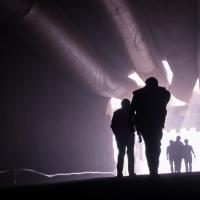There they were — spotted from above by an armada of low-cost little satellites. They’ve seen new cities built and secret nuclear missile silos, mapped coral reefs and rainforests, but now, satellite mapping and data company Planet’s satellites have revealed a stunning violation of human rights: a massive network of internment camps in the Xinjiang autonomous region of northwestern China.
They are built to house the Uyghur, a majority-Muslim ethnic group, and other predominantly Muslim groups that the Chinese Communist Party has been targeting since 2014, in a campaign human rights groups call a cultural genocide.
Buzzfeed News won a Pulitzer for exposing the camps, in part by analyzing data from Planet.
It was a dramatic example of the power of what Planet calls “agile aerospace.” By building many cheap, expendable, and constantly upgrading satellites, and throwing them up into orbit, Planet can catalog the Earth with a breadth and speed that a single large satellite cannot.
“We have a database of how the Earth is evolving at every X, Y coordinate of the planet at every time, going back five yeas,” says Kevin Weil, president of product & business at Planet.
“Being able to see the entire Earth every single day, and how it’s evolving, it is a new capability for humanity. It’s never been possible before.”
Why We Map
Planet’s capabilities may be an order of magnitude different than those of previous satellite mapping efforts, and certainly of older maps. Imagine, for example, seeing the day-to-day changes in the shoreline of a coast, as opposed to navigating via a chart drawn years before you arrived.
But Planet’s satellite mapping goes back to an ancient human desire: to know what is beyond us, to have access to that information in an accessible, understandable way, and to be able to act on that information.
National Geographic has a succinct definition of a map; that it is a “symbolic representation of selected characteristics of a space.”
A map is a shorthand, a way of compressing untold amounts of information — rivers winding, mountains climbing, political boundaries being drawn — into something we can use.
These 2D representations — the literal flattening of our world — have had an outsized impact in human history. Ever since an ancient Babylonian cartographer carved, over 2,000 years ago, the oldest known map into clay, they have revealed information not only about the world but also their creators.
After all, Babylon was at the center of that map.
“From this first world map to the numerous digital maps created today, maps of the world have a tremendous influence on how people and societies view themselves and their place in the world,” reads the introduction to the Library of Congress’s Maps That Changed Our World.
Sketching the World
Ancient scholar Claudius Ptolemy provided one of the first detailed maps of the world, as known to the Roman Empire. His Geography contained over 8,000 locations, mostly around the Mediterranean.
With satellite mapping millenia away, Ptolemy managed to chart his known world from the Canary Islands to Korea. Much of that world was accurate; other parts were not, like a landbridge Ptolemy speculated connected Africa and Asia on the southern end of the Earth. The math Ptolemy used to create his map ended up being flawed, but that he used math at all set the bar for cartographers going forward, according to the Library of Congress.
Those cartographers included Muhammad Ibn al-Idrisi, commisioned by the King of Sicily to map the world in 1138. With north at the bottom of the page, customary in Islamic maps, al-Idrisi’s map drew on Greco-Roman, Arabic, and theological knowledge. He also presented the world as a sphere, and alluded to gravity, providing planet-wide context.
As more and more money and power began to hinge on accurate navigation, maps became more accurate — or at least in the parts people care about.
Coastal maps of North America key to the fur trade were painstakingly crafted; but a few miles inland, they were a blank space.
“The coastlines were accurate, but they weren’t as concerned about the interiors,” cartography expert John Rennie Short told Smithsonian Magazine. “The rest is, like, Who knows? As long as you keep bringing the beavers, we don’t care.”
The Mercator Projection of the 1500s — i.e., what you think of when you think of a map of the world — allowed for more accurate navigation, Smithsonian notes, but at the expense of physical accuracy.
Eyes in the Skies
Today, satellite mapping has forever changed the accuracy with which we can map. GPS satellites can deliver a pinpoint position Ptolemy would have never conceived of as possible. Under perfect conditions — open sky, few buildings and trees around — your smartphone can be accurate to a 16 ft. radius.
And new orbital and airborne sensor technologies, with an assist from AI, can reveal more than your position at sea or the nearest Walgreens — they can uncover and map what we cannot see.
LiDAR technology bounces lasers off the ground, recording what comes back and compiling that information into highly accurate 3D models.
By taking this information and stripping away the foliage, archeologists have completely revolutionized the study of the Maya civilization, revealing massive complexes and structure previously hidden, and throwing into question what we once thought we knew about these powerful kingdoms.
AI computer vision systems have made satellite mapping more useful than ever before.
Using AI, Planet can automatically identify and categorize what their satellites see, creating something like a true global database of “what’s on the world.”
“Using computer vision, we can abstract out objects. Then we basically build up a database of all of the objects on Earth over time,” Will Marshall, Planet co-founder and CEO, says.
“And that database should be queryable; you should be able to just say ‘well, how many roads are there in Pakistan?’”
Understanding Our Planet
Planet sees satellite mapping as a way of understanding our world holistically, beyond politics and geography to see the Earth change itself.
Marshall notes protecting the ecosystem as a key example of what Planet’s technology can do; they can stop illegal logging in advance, because they can see the roads being cut into the forests before the harvest begins. Planet performed the first coral reef satellite mapping project, and can now — because we can watch it change day to day — lookout for coral bleaching or illegal fishing.
Governments can keep an eye on each other, and citizens keep eyes on their governments.
Regular satellite mapping may provide us with untold amounts of data — and untold future uses.
“I think that our grandchildren will look back at this time and be flabbergasted that we were trying to take care of the planet without regular information about the planet,” Marshall laughs.
For Planet, satellite mapping may be the key to perceiving our home in a new way, a spiritual successor to the impact of NASA’s Blue Marble, the first photograph to capture all the Earth.
That shocking sight of a vulnerable, precious home in the vastness of space will live and change as we do, the view of the world static no more.


